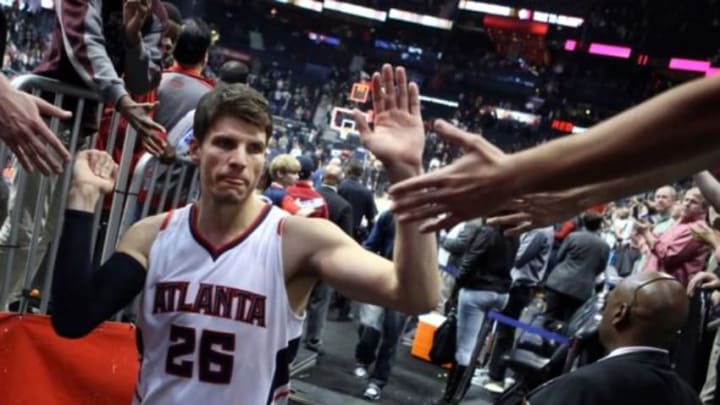It almost happened.
The NBA universe almost threw all anecdotal stats out the window and recognized a player whose impact cannot always be seen with the naked eye.
Kyle Korver was almost an All-Star.
More from Hoops Habit
- The 5 most dominant NBA players who never won a championship
- 7 Players the Miami Heat might replace Herro with by the trade deadline
- Meet Cooper Flagg: The best American prospect since LeBron James
- Are the Miami Heat laying the groundwork for their next super team?
- Sophomore Jump: 5 second-year NBA players bound to breakout
Make no mistake, however, the crop of Eastern Conference All-Star guards this year; namely, Jeff Teague, Jimmy Butler, Kyrie Irving, and Dwyane Wade — are all deserving of their spots.
But, for a while it seemed the league was straying away from conventional wisdom, and entered in a new era of team basketball — where teams with ball movement, creative floor spacing, and disciplined rotations, like the Golden State Warriors and Atlanta Hawks, rule the association, and a player’s worth did not necessarily have to be vindicated by averaging more than 20 points.
The all-star case for Korver has been thoroughly documented. While he lacks the traditional “all-star” resume — averaging a ho-hum 13 points per game, shooting it only eight times a game, and is used in only 14.4 percent of the Hawks’ possessions this season, per NBA.com — Korver is having a historical shooting campaign, converting on 53.4 percent of his six 3-point attempts per game.
His effective field goal percentage (eFG%) is currently at 71.2 percent, and he leads the NBA in true shooting percentage (TS%) at an unfathomable 74.1 percent, per Basketball-Reference.
Notably, Korver is the type of shooter with relentless energy that tires the opposition with eternal off ball movement; and with little to no breathing room, he’ll demoralize his defender by draining a highly contested three at the most opportune time.

In fact, not only does Korver shoot at a 76.0 percent effective clip on catch-and-shoot opportunities, he also scores at an eFG% of 60.3 percent on contested attempts — under duress — with the closest defender within four feet of him, per NBA.com.
Korver’s otherworldly shooting and never-ending man movement makes him a climacteric figure on the offensive end; just like Irving, Teague, Butler, and Wade. The caveat being he does it without the ball.
As fans, we have always marveled at the type of ball-hawking, on-ball defense that Butler applies on a nightly basis, and the off-the-dribble wizardry that Wade and Irving showcase game in and game out.
Consequently, little nuances that lead to winning, such as digging and recovering on a post-up, bumping a diving big at a nail then hustling to run your man off the 3-point line, and helping the helper, gets swept under the rug.
Similarly, we have generally ignored how much chaos continual off-ball movement can cause, especially when paired with deadly shooting.
Glue your eyes on Korver on an offensive possession and you’ll begin to appreciate him for something more than a “13-point per game shooting specialist” — watch the amount of attention he gets coming off of screens, how he forces the opposing defense to make multiple decisions within one possession, sit back and enjoy how he causes defenses to scramble, crumble, and breakdown without even touching the ball. That, my friend, is all-star impact.
And if you want statistical evidence to match the eye-test, that’s fine. Over the past month, in which the Atlanta Hawks have gone undefeated, Korver — not Teague, not Paul Millsap, and not Al Horford — has led the team in Net Rating by nearly four points per 100 possessions and has accumulated a jaw-dropping eFG% and TS% of 78.6 percent and 79.5 percent, respectively.
Furthermore, he’s second among all shooting guards — ahead of the much-heralded Klay Thompson, Butler, and Wade — trailing only James Harden, in Real Plus-Minus (RPM), per ESPN. In fact, he is a net positive on both the offensive and defensive ends of the floor — as opposed to Wade, and surprisingly, Butler, of whom are both net negatives on the defensive end.
At age 33, this may very well be Korver’s last and only legitimate shot at an all-star spot — that fact alone is disheartening. However, even being in the discussion and receiving strong consideration shows that we are moving towards the right direction.
Hopefully, when the “next Korver” arrives, the NBA community will be educated enough through the lens of the NBA’s slew of “new” stats and appreciation for what really leads to winning, and thereby, appropriately award and recognize his true impact.
